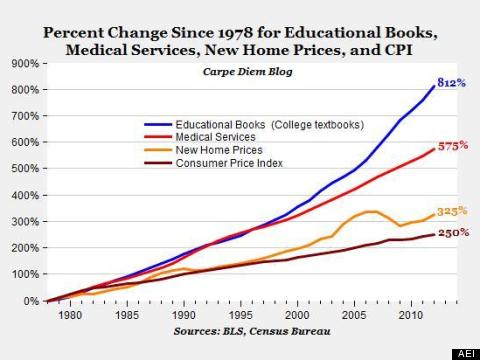WEST LONG BRANCH, NJ – Over the past decade the cost of education has been steadily rising. More often than not, the cost of college education is divided intro three major categories: tuition and fees, boarding costs, and meal plans. Equally important is a fourth major category: textbooks and supplies.
While it may be surprising to classify textbook expenses as a major contributor to the cost of college education, such a classification is justified given the price tags of contemporary textbooks. According to a recent study done by a consumer advocacy group, U.S. PIRG, the cost of college textbooks rose 82% between 2002 and 2013. As analyzed by the Government Accountability Office, this is nearly three times the rate of inflation in this country.
Textbook publishers typically print a new edition every few years. On average, the newer edition contains the exact same information in a different format or, at the very best, these newer editions have a few new pictures within the text or on the cover. Most of the time the problems and supplemental questions at the end of the chapter are the exact same as the former edition, offering little advancement within the text.

In a 2006 report by the U.S. Education Department, James V. Koch stated “the [textbook] industry is an oligopoly,” lending support to the argument that textbook publishers have established an unconditional monopoly over the education market.
According Tomas Villas, a Monmouth University Math major, the textbook market is generally functions via a market price system, which usually has little distortion; in other words, the textbook market is extremely good at making profit. Students, whose professors may assign a specific textbook to the class, are forced to buy that specific textbook in order to succeed in the class. The students have no choice in terms of textbooks and they can’t pick and choose between two different textbooks of the same subject. Therefore, the textbook publishers have absolutely no inclination or necessity to appeal to their consumers—the students. As a result, they have established this unwarranted system which forces students to spend hundreds of dollars in order to buy their product.
The study done by U.S. PIRG further reported that due to inflated prices, 65% of the students across the nation had decided against buying a textbook as it was too expensive. These students had made the decision fully aware of the fact they may be at the risk of doing poorly in a class due to this.
Kara Synader, a Monmouth sophomore, stated, “Since textbooks prices are so high, I always hesitate to get the physical copy, even though I prefer to highlight and write in my books. But usually, I have to resort to ebooks or renting books,” emphasizing the drawbacks of overly priced textbooks.
Moreover, 48% of the students reported that the cost of textbooks impacted on how many or which classes they registered for per semester.
An increasing number of students are therefore buying e-textbooks that may be read online. However, the textbook publishers have placed expiration dates and printing restrictions in order to maintain the control of the market.
Ishita Bhattacharya, a sophomore at Monmouth University, stated “My Anatomy books and online homework code cost $400.00 I am already paying for my education, let alone paying to do my homework. Universities might as well include book fees in their tuition so that I know the cost of my real education.”
Students also argue that such high price of textbooks and online codes not only disrupts their learning, but also places unnecessary financial stress on them, further adding to their pile of debt.
Danielle, a Monmouth sophomore added, “The fact that students also need to worry about how they will afford to pay for their textbooks books really adds unnecessary stress that has the potential to ruin the education we struggle to afford to begin with.” As proved by the PIRG report, the opinions of Monmouth University students resonate with those of collegiate students nationwide.
Universities have introduced “open books” books to their curriculum due to the rising cost of education. Open books are authored and edited by experts in distinct subject areas and are available for students’ use online. However, unlike, regular undergraduate textbooks, they are completely free. Many professors across the nation have adopted this system and the findings suggest that students enrolled in such courses, perform significantly better. Perhaps, this might be an alternative Monmouth faculty may want to consider.




